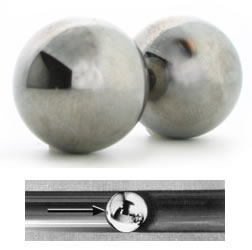
Tubes and other hollow passages often require ballizing. Also known simply as ball sizing, it’s a roller burnishing process. Roller burnishing processes are designed to remove superficial imperfections. While most roller burnishing processes involve the use of hardened rollers, ballizing involves the use of a ball. What is ballizing exactly, and how does it work?
What Is Ballizing?
Ballizing is the process of forcing a ball through a hole. The ball has a slightly larger diameter than that of the hole through which it’s forced. With its larger size, the ball will remove superficial imperfections while subsequently finishing the hole.
How Does Ballizing Work?
When tubes and hollow passages are initially manufactured, they may contain imperfections. Their inner walls may contain burrs, for instance. If left unchecked, burrs and other types of imperfections may degrade their performance. Ballizing, however, offers a simple and effective solution.
By forcing a slightly oversized ball through a hole, you can remove imperfections on the inner walls of the holes. The balls used in ballizing are made of strong, heavy-duty materials. When forced through holes, they remove imperfections on the inner walls.
The Benefits of Ballizing
There are other ways to finish and remove imperfections from holes. Ballizing, though, offers several benefits that make it a popular choice among businesses.
Ballizing is easy to perform. It’s known as “ballizing” because it’s designed to “resize” holes using “balls.” Resizing, of course, will remove imperfections so that the holes become smoother and more uniform. Regardless, you can perform ballizing using a ball and a machine like a press, or milling machine. As long as you have access to these items, you can use ballizing to finish holes.
In addition to being easy to perform, ballizing is inexpensive. It costs less than other finishing processes. If you’re on a budget, ballizing is the way to go. You can use it to easily finish holes — all while saving money in the process.
You can rest assured knowing that ballizing produces consistent results. The hole through which you force a ball will always take that ball’s size. You can achieve different sizes for holes, of course, by using different balls. For a larger hole size, switch to a larger ball. For a smaller hole size, use a smaller ball. Either way, ballizing produces consistent results that reflect the balls used in this finishing process.
